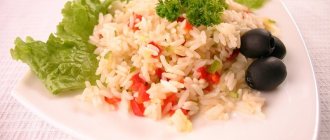Ayurveda for weight loss nutrition rules When I first heard the word Ayurveda, I decided that it was someone’s last name, or first name, in extreme cases. Subsequently, I was very surprised to learn that this Indian technique is a real science of life.
However, first things first. My interest in this system did not arise by chance. My legs began to hurt badly and the doctor advised me to pay attention to my body weight. He said that Ayurveda (Ayurveda) would be suitable for me.
It is safe for health and good for weight loss. The nutrition rules there are not complicated, you can always find food, the main thing is to want it. It's been 2 years already. The weight gradually returned to normal. I only remember about my legs after heavy loads.
Key points of nutrition according to Ayurveda - about the doshas
Dosha is a complex concept in the Ayurvedic system, which combines the constitutional characteristics of the human body, character, and temperament. A harmoniously developed personality consists of three balanced doshas, but in reality such a standard is rare.
More often than not, one or the other dosha pulls the blanket over itself. To find out the percentage of doshas in your body, you can use one of many tests. The test requires at least 30 minutes of free time and thoughtful answers that impartially characterize the state of your body, well-being, and attitude.
Dosha Vata
Externally, people of Vata constitution are distinguished by thinness, bonyness, long limbs, narrow chest, and protruding joints. Metabolic processes in their body proceed extremely quickly.
As a result, this category of people is generally not inclined to be overweight. They have another problem - the inability to get better even with a strong desire. According to Ayurveda, weight loss is not recommended for Vata people, because it threatens exhaustion.
The Vata person is impetuous, chaotic, cheerful, has a wonderful imagination and a great sense of humor. A cheerful fellow and the life of the party. Among the disadvantages of this wonderful constitution are susceptibility to nervous breakdowns, cardiovascular diseases, and endocrine diseases.
As for nutrition, in order to gain a little weight and balance other doshas, it is necessary to increase the amount of sweet, flour, and oily foods. But you need to avoid spicy, bitter and astringent foods (such products enhance metabolic processes and lead to weight loss).
Dosha Pitta
People with a Pitta constitution have an average build, moderately muscular and of acceptable stature. They have a good appetite, sometimes excessive. They gain weight easily and lose it just as easily. Among the main problems are diseases of the digestive system and skin.
The main reason for obesity in the case of Pitta is simple overeating.
Although a Pitta person rarely suffers from obesity, he gains weight easily within the range of 5–10 kg. Losing weight according to Ayurveda for this constitution involves following a number of recommendations:
- increase the volume of bitter and astringent products (leaf lettuce, broccoli, artichokes);
- reduce the proportion of sour, salty, spicy;
- do not overeat, eat regularly and nutritiously;
- try to eliminate dairy products, nuts (lots of fat);
- Choose sweet fruits (grapes, melon), limit sour ones (grapefruits);
- the main source of protein is chicken, reduce the consumption of beef and seafood;
- lean on rice and oats, limit the amount of corn and rye;
- fasting days are not only acceptable, but also recommended.
Remember, if you are Pitta and suddenly gain weight, most likely you are abusing your appetite. Moderate it and you will be slim.
Dosha Kapha
Kapha is the fattest of the doshas. People of this constitution have a large build and are prone to rapid weight gain and slow weight loss.
In life, Kaphas are peace-loving, sentimental, and stress-resistant (unlike Vata). Health threats include obesity, endocrine diseases, and allergies.
An effective way to lose weight according to Ayurveda for Kapha is to strictly follow the rules:
- sweet, sour and salty are prohibited;
- emphasis in nutrition - on spicy, astringent, bitter;
- avoid overeating (Kapha gets better even from the thought of food);
- give up dairy products;
- greatly reduce the amount of fat;
- rice, wheat, corn, oats are prohibited;
- bananas, melon, avocado are also in the TOP excluded;
- prefer vegetables to any meat (with the exception of potatoes, tomatoes and zucchini).
For Kapha, aerobic exercise is an important rule for losing weight. Their metabolism is greatly slowed down. It needs to be regularly stimulated, and the best way to cope with this is through a load that increases the heart rate.
In addition to specific recommendations, losing weight according to Ayurveda means following general nutritional rules. “The Science of Life” gives competent instructions on organizing your diet. And they apply to all three types of doshas. Source: ezoterik-page.com
The general rules of the Ayurvedic diet are simple:
- Do not mix immiscible products
- Start eating only when you feel hungry
- Eat only fresh food
- Don't be distracted from food
- Don't wash down your food
Further recommendations are individual in nature and stem from your dosha type, therefore, before starting a diet, you should determine your dosha, this is an important definition in Ayurveda nutrition for weight loss.
Having determined your dosha, follow the rules:
If you want to lose weight, eat as if you were a kapha.
Only pure Vatas do not gain weight. These are people of the wind, light and sonorous, and for them the problems of excess weight are unknown (what’s up, they often forget to eat altogether!)
Everyone else needs to put in effort to stay slim.
Kaphas gain excess weight most easily. People of this type find it extremely difficult not to gain weight; it seems that just the thought of food makes them fat! Kapha has to constantly control himself. Become a kapha while losing weight according to Ayurveda: give up sweet and salty foods; white rice, wheat, corn and oats. Love apples, and forget about sweets (you can use a little honey). Exclude bananas, melons and coconuts from fruits, and pork from meat (your choice during the diet is chicken, fish). During the diet, you can generally become a vegetarian.
Avoid eating dairy products and nuts. Give preference to salads and light vegetables (potatoes are a heavy vegetable!)
Drink more
Your choice is clean water (don’t forget about the obligatory glass of water in the morning!) and small quantities of freshly squeezed juices. Water should be drunk between meals (Ayurveda does not recommend drinking food with food).
Ayurveda for weight loss, nutrition rules, features of the ancient oriental diet
The principles of the ancient Indian teaching of Ayurveda have been preserved in the Vedas to this day. They can be successfully used not only to improve your well-being, but also to lose weight.
Basic rules of nutrition according to Ayurveda
- Eat only natural, healthy food. It should be prepared shortly before the meal and only in a good mood;
- Eat fresh vegetables and fruits in raw form;
- Eat only when you feel hungry, but it is better to refuse to eat if a person feels tired or is in a bad mood;
- Combine only compatible foods in one meal, so as not to weaken the body with excess toxins;
- You should fast from food once a week and never eat before bed;
- Include 6 tastes in the diet: bitter, spicy, salty, astringent, sour and sweet;
- Avoid taking fruit juices and drinks;
- Use spices;
- Eat slowly, chewing everything well;
- Trust your inner feeling, eat what you want.
Source: ayurveda-info.ru
Followers of Indian medicine explain excess accumulation of fat in the body by slagging. Poorly digested and not fully absorbed food is broken down with the formation of waste substances.
The latter come in two types: water-soluble and fat-soluble. Toxins of the first type can be easily eliminated through exercise and fasting nutrition. But with the second type of toxins, everything is more complicated, since they remain in the cells of the body and cause increased synthesis of fat molecules.
However, the situation is not hopeless. Doctors practicing Ayurvedic principles have developed special methods for cleansing the intestines and the body as a whole. With their use, a person is able to achieve certain success in losing weight and normalizing metabolic processes.
Diet
This is one of the basic principles and must be observed constantly. Ayurvedic teachings recommend starting the day at 5–6 am, and finishing, that is, going to bed, at 10 pm. This time is justified from a physiological point of view - the activity of the liver, which plays the main role in detoxification, is active around one in the morning.
If a person is not yet sleeping at this time, the liver works “at low speed” and the level of toxins in the body not only does not decrease, but also increases.
Meals should be three times a day: breakfast, lunch and dinner. But there is one exception to keep in mind: three meals a day is not suitable for people with low blood sugar.
In the morning you should have a full healthy breakfast. With this daily routine, lunch should be at 12–13 o'clock. Dinner should be planned approximately 4 hours before going to bed so that the gastrointestinal tract has time to fully digest the food eaten.
The most abundant food in terms of volume is lunch - it accounts for 50% of the daily diet. Breakfast and dinner should be 25% each.
Natural products
All products used in food must be natural, without the addition of preservatives, flavor enhancers, dyes and flavors. In addition, Ayurveda recommends consuming seasonal products. That is, vegetables and fruits bring the greatest benefit at the time when they ripen.
One-day unloading
To lose weight and cleanse, Ayurveda recommends a so-called fast once a week. This could be a regular fasting day.
Ayurveda is a fundamentally different view of slimness. She does not dictate strict standards, but prefers to stick to the golden mean. She does not prohibit, but recommends.
The menu for fasting must be selected individually, based on your own constitution, time of year and state of health.
Drinking regime
This point of the nutritional rules according to Ayurveda states that drinking water before or immediately after meals is undesirable. The ideal option is to drink clean water in small portions (several small sips) throughout the day. It is strictly not recommended to drink cold water, especially after meals.
Combination of flavors
This principle of nutrition is given great importance in Ayurveda. And it is also important for losing weight. There are only six flavors:
- sour
- sweet
- salty
- bitter
- spicy
- astringent
The menu for each day should be designed in such a way that these tastes are represented to the maximum in the dishes. This task can be greatly facilitated if you use an Ayurvedic fat-burning seasoning. Source: m-figura.ru
Principles of Ayurveda nutrition for weight loss
Ayurveda nutrition for weight loss has some principles that need to be followed. They relate to the peculiarities of organizing a weight loss lifestyle according to ancient Indian teachings.
Schedule
Ayurveda recommends going to bed and waking up early. The best time to sleep is from 10 pm to 5-6 am. Throughout the day, the human body will be as active as possible, and at night it will be able to fully rest. If you follow this simple rule, the problem of excess weight will begin to be solved naturally.
Diet that promotes weight loss
If a person has normal blood sugar levels, then eating three times a day would be ideal. Dr. Kulreet recommends eating a healthy breakfast, a nutritious lunch, and a light dinner. It is best to have lunch at 12-13 o'clock in the afternoon.
In order for the body to actively detoxify, the liver must rest at night. That is why dinner should be no later than 19 pm with a minimum of calories. It is important to eat in silence, without the background of TV, radio or YouTube videos. Don't read a newspaper or book - focus on food. Enjoy the taste and notice the gradual saturation.
Fasting and therapeutic fasting
Ayurveda solves many nutrition and slimming problems. How to lose weight through fasting or therapeutic fasting? To detoxify the body, you need to regularly fast and refuse food. Fasting should be done every week. From time to time, it is worth using therapeutic fasting for several days to remove toxins and other dangerous substances from the body.
Product combination
Ayurveda is a science that involves adherence to certain principles that are important for human health. There are common combinations that Ayurveda prohibits. Excess weight may not go away if incompatible components are present in your diet.
Only natural ingredients
In nature you can find absolutely everything that the human body requires. Ayurveda for weight loss involves eating seasonal fruits and vegetables. The basis of the diet should be rice and wheat.
The role of taste for weight loss according to Ayurveda
As mentioned above, taste plays a very important role, as indicated by the basic principles of Ayurveda. Nutrition for weight loss involves the use of six different flavors at once. Please note: flavors must be seasonally appropriate.
Water and other drinks
It is not advisable to drink water shortly before eating or immediately after eating. But throughout the day you can drink warm water in small sips. This will have a positive effect on digestion. You should not drink cold water, especially after meals.
The principle of "six tastes"
Ayurveda distinguishes six basic tastes that all foods have.
- Sweet taste is present in foods such as rice, milk, sugar, wheat, honey, dried fruits, buckwheat, carrots, beets, pears, grapes, potatoes, onions, some berries, melon. They provide a quick release of energy, producing an invigorating effect. Sweet-tasting foods stimulate the production of serotonin, which gives you a feeling of pleasure. However, it is important to know that foods with a sweet taste contribute to obesity, poor digestion, fermentation in the intestines and the onset of diabetes. For people prone to Kapha, it is best to completely exclude them from the diet or consume them little by little in the morning.
- Most berries, citrus fruits, fermented milk products, rhubarb, tomatoes, pineapples, papaya and vinegar have a sour taste. If used wisely, they effectively improve digestion and give vigor and energy. Excessive consumption can cause increased appetite, heartburn and stomach ulcers.
- The salty taste is characteristic of meat, salt, seaweed, soy sauce, and miso paste. Moderate consumption of salty foods maintains and restores a healthy water-salt balance in the body, improves digestion and absorption of food. An excess of salty foods leads to edema, additional stress on the kidneys, increased appetite, deterioration of blood circulation and skin condition.
- We feel the spicy taste in a variety of red peppers, ginger, wild garlic, onions, garlic, mustard, and radishes. This taste warms very well, stimulates salivation and appetite, improves digestion and blood circulation. In addition, the spicy taste serves as an excellent prevention and treatment of colds and inflammatory diseases. However, spicy foods should be consumed with caution, as they can cause nervous excitement, heartburn, ulcers, indigestion, and even decreased reproductive function.
- A bitter taste is inherent in almost all medicinal herbs, as well as aloe, dandelion, coffee, sorrel, turmeric and sandalwood. Most often, the bitter taste is not consumed as food, but a variety of medicinal teas are prepared with it. With its help, you can effectively reduce high body temperature, improve the flow of bile and liver function, treat bacterial diseases and remove toxins from the body. Since no one will be able to consume too much bitter food or drinks, do not limit yourself to it. Various medicinal herbal teas can be drunk every day throughout the day.
- All legumes, cauliflower, celery root, green beans, artichokes, pumpkin, lettuce, pomegranate and bananas have an astringent taste. Products that have an astringent taste perfectly saturate, stop bleeding, heal ulcerative damage to the mucous membrane and skin, and also give the body vigor. Excessive consumption can cause flatulence and constipation.
It is very important that food contains a balance of these tastes, depending on the person’s constitution. By following the simple rule of balancing tastes, you can forever get rid of excess weight and health problems without diets or restrictions.
All food should contain these tastes, however, to correct health or figure problems, their content in the diet can be varied. Source: wowdiets.ru
Best time to eat food
Let's look at simple Vedic rules for eating and what Ayurveda tells us about the timing of meals.
Breakfast
Many people who are not familiar with the laws of Ayurveda deliberately avoid this meal, because it immediately makes them sleepy. They say: “I don’t eat breakfast. I have too much to do!”, referring to the drowsiness that inevitably comes from ignorant foods. Forget once and for all about buns, sandwiches and porridge (everything except light buckwheat) and the morning will be good!
Wake up at six in the morning and try juicy, sweet fruits. Any dairy product, according to Hindus, will be good for you. This also includes milk (we wrote about it earlier). And for goodness sake, eat sweets!
A woman simply needs this to balance her hormonal levels. Dried fruits, chocolate, and raw food candies are allowed. Even if you're on a diet. Everything will be digested without consequences within 12 hours. There is only one ban - cakes (because of the shortcakes). Otherwise, you will eventually become an irritable, angry person, take pity on your man.
Meals are given special importance in Ayurveda
Dinner
The ideal time for it is from 11:00 to 14:00. During these hours, digestion is most active, fueled by solar energy.
Get into the habit of cooking grains, legumes, and fried vegetables. They will help nourish the mind and improve mental performance.
The main thing is to respect the time frame and not overeat.
This reduces willpower and the ability to concentrate. Strenuous work should be avoided for the next hour. Dinner is considered the most important meal of the day
Dinner
The most important meal of the day. It will depend on it whether putrefactive processes will occur in your stomach or not. Eat and feed your loved ones stewed vegetables or nuts. Avoid butter and bread if possible. The fruits will help you relax after a hard day, relieve nervous tension and prepare for a good night's sleep.
Avoid the fire-heavy digestion of potatoes. It is better to focus on above-ground vegetables (cabbage, zucchini, cucumbers, herbs).
Advice: in summer, eat more fruits. In the fall, switch to cheese, sour cream, ghee, buckwheat porridge with sugar. In winter, continue to eat fats, add sweet spices, but avoid cooling ones (for example, mint). In spring, the use of fennel, cinnamon, and caraway is encouraged.
The only fermented milk allowed is heated milk with spices. Indians generally have a particularly warm attitude towards this product. Even down to the rule: if after milk a person feels bad or has a nightmare, you drank too little of it.
You should accustom yourself to it gradually, starting with a teaspoon, slowly increasing the dose. If it's still bad, avoid it completely, it doesn't suit your needs.
Source: life-reactor.com
Rule 1 – Diet
This is one of the basic principles and must be observed constantly. Ayurvedic teachings recommend starting the day at 5-6 am, and finishing, that is, going to bed, at 10 pm. This time is justified from a physiological point of view - the activity of the liver, which plays the main role in detoxification, is active around one in the morning. If a person is not yet sleeping at this time, the liver works “at low speed” and the level of toxins in the body not only does not decrease, but also increases. Meals should be three times a day: breakfast, lunch and dinner.
But there is one exception to keep in mind: three meals a day is not suitable for people with low blood sugar.
In the morning you should have a full healthy breakfast. With this daily routine, lunch should be at 12-13 o'clock. Dinner should be planned approximately 4 hours before going to bed so that the gastrointestinal tract has time to fully digest the food eaten. The most abundant food in terms of volume is lunch - it accounts for 50% of the daily diet. Breakfast and dinner should be 25% each.
Read on the My Figure website:
Lemon water - all the secrets of using it
Signs of poor digestion and habits to avoid
- You should always listen carefully to the sensations of your own body. It's especially difficult at first.
- This is due to the imposed habits of childhood, the opinions of others, and cultural characteristics.
- By the way, a woman’s body always feels what it needs better than a man’s. It's all about an intuitive approach to many things.
- After eating, your stomach should feel pleasantly light.
- You should not feel heaviness or apathy after eating.
- A bad sign is drowsiness, irritability or laziness - it means that it does not suit the constitution and is harmful to you.
- Although seemingly harmless, these ingredients can cause intoxication, bloating, pain, dizziness and even vomiting.
- In this case, you should urgently consult a doctor and remove them from your diet.
- The urge to have a bowel movement ideally occurs the next morning after consumption, if earlier, they are toxic for you.
- Another sign of poor digestion: bad breath. It would seem that everything is so simple, but many do not always listen to the small clues of their own food reactions.
Essence and principles
Ayurvedic nutrition has come into our time since ancient times, but today it is valued no less. The daily routine always depends on the activity of the body and the Sun. According to this method, breakfast should fall within a period of 7-10 hours. It is during this period that Kapha is active, so you need to maintain its balance. The essence of the technique is to eat lightly and without calories, without creating unnecessary stress on the body, without taking away energy for digesting food.
Breakfast should be light and balanced; bananas, cheeses, milk, fermented milk products, sweets and flour products are not recommended. The best option would be muesli, oatmeal and others. The Ayurvedic method completely eliminates the option of not having breakfast. It must be there at the allotted time.
Products for consumption must be fresh, only prepared. The technique does not imply the use of yesterday's dishes and products in their pure form.
Lunch according to this food system is an equally important component; the best time for it is 12-13 hours. It is allowed to use soups, cereals, legumes, and vegetables.
Dinner before 20:00, it should be of minimal calorie content. The best options are cereals, nuts, and fresh vegetables. They are quickly absorbed by the body and do not create unnecessary pressure on the stomach.
The Ayurvedic diet has the following principles:
- Food should be taken in a calm position, without haste.
- After each meal there is a rest.
- It is forbidden to overeat.
- Eat only when you feel hungry.
- The food after the last meal should be completely digested.
- It is forbidden to drink cold drinks.
- Eating should take place in a good mood.
Compliance with all the rules and principles of such nutrition will help improve your body’s health, remove harmful substances from it and achieve weight loss. It occurs by optimizing metabolic processes and improving the functioning of the digestive system.
Time to sleep and time to eat
An excellent result of any activity depends on regularity and consistency. Same with weight loss. The Ayurvedic diet focuses on the direct dependence of the state of the body on the time of waking up and falling asleep, as well as the time for eating. You need to wake up and go to bed with the Sun.
For a modern person, getting up at 5–6 in the morning is still possible, but going to bed after sunset is very problematic. In the current situation, the time between 10 and 11 pm is optimal for going to bed.
7–8 hours of healthy rest and early awakening will allow you to slowly and calmly cope with your morning routine and set the required pace for your body’s work thanks to a clear nutrition plan.
According to Ayurveda, 25% of the daily diet should be in the morning and 25% in the evening, and the largest meal is for lunch.
The main thing is not to overeat at night, because at this time the body adjusts to rest and can no longer cope with heavy loads, and the accumulated calories turn into fat, not energy. Source: yogavedi.ru
Golden Rule of Ayurveda
When eating food, correctly determine its volume and structure. Two parts of the stomach should be occupied by solid food, the third part - for water and part - for the movement of Air. It is this rule that many people violate, because we instinctively feel fullness from eating when our stomach is “full to capacity.”
But in this case, he will not be able to properly digest the food he has taken. This is such a trap. This is why many nutritionists recommend not eating a little, and Ayurveda recommends dividing the entire volume of food into four parts, one of which is air.
Thus, given that the normal volume of the stomach is 1 - 1.5 liters, at lunch there should be approximately the following volumes of food: solid food - 500 - 750 ml, soup, drink and other liquids - 250 - 375 ml, air, which is important for digestion - 250 ml.
Everything that comes from above will, of course, fit in your stomach, since it can easily stretch and accommodate 3 - 4 liters. food, but the food will not be digested properly this way. Source: mudrostmira.ru
Ayurveda for weight loss: nutritional rules
Followers of Ayurveda explain the accumulation of waste and toxins in the body by eating fatty foods. The body cannot cope with its digestion, which contributes to the accumulation of harmful substances. In Ayurveda they are called Ama, which comes in 2 types:
- Water-soluble, which is eliminated through physical activity and diet.
- Fat-soluble, stuck in the intracellular space and provoking the formation of fatty deposits. This type of fat is more difficult to get rid of.
Followers of the technique need to plan their day in accordance with the state of the body and the activity of the Sun. The morning meal should be taken during the period when Kapha is active to maintain its balance. This time period is between 7 and 10 o'clock. The most important principle of the system is low-calorie nutrition, which does not burden the body and does not waste its energy on digesting food.
You should have breakfast only with freshly prepared food. It is prohibited to eat food prepared the day before. Women losing weight according to Ayurveda cannot refuse breakfast. But it should be easy and at specified intervals. It is worth giving up fermented milk products, bananas, milk, cheese, sweets, and baked goods. It is recommended to give preference to the following products: oatmeal, muesli and others.
Followers of the method should have lunch between 12 and 13 hours. Lunch is no less important than breakfast. You can't miss it. For lunch you can eat dishes prepared using grains, beans, vegetables, as well as soups.
For dinner, followers should use foods with the lowest calorie content. Dinner may consist of nuts, fresh vegetables, and cereals. Food should be easily digested without burdening the body. The optimal time for dinner is 20.00.
Physical activity and sports are inextricably linked with the Ayurvedic diet. Preference should be given to yoga. It will help strengthen muscle tissue and develop joints.
Think and lose weight
Eating right isn't the only thing you need to learn when losing weight. Ayurveda teaches not only how to eat correctly, but also how to think correctly in order to bring harmony to the body and get rid of imbalances. Physical perfection is possible only when spiritual balance is achieved.
The causes of excess weight can be not only diseases of the body, but also a lack of joy and positivity in life, uninteresting work and daily stress. Fortunately, this is fixable. Your thoughts should bring goodness, purity, love for yourself and others. Then whatever you do will be for your good.
This diet is actually very simple. You just need to eat right and think right. Try to find something you like, it could be yoga and meditation, or it could be dancing, drawing, singing.. Source: yogavedi.ru
Ayurveda recipes and principles of Ayurvedic cuisine
Ayurvedic cuisine is a kind of philosophy where it is believed that if you follow certain nutritional rules, food can not only be nutritious, but also perform some kind of healing and health-improving function.
Ayurvedic recipes are created not only to satisfy hunger, but also to improve the digestion process, which will provide the human body with physical and spiritual healing.
Fennel tea with lavender.
Ingredients:
- 3 glasses of water
- 0.5 tsp. dried lavender
- 0.5 tsp. fennel seeds
Semolina kheer.
Ingredients:
- 1 tbsp. semolina
- 8 tbsp. milk
- 0.5 tbsp. ghee
- 1 tbsp. chopped almonds
- 1 tbsp. sucanata or honey
- 1 tbsp. l. nuts charoul
- 0.5 ground cardamom
Recipe:
Place ghee in a heated pan, then semolina and, stirring evenly, fry until light brown. Now, stirring well, pour in the milk in a thin stream. Care must be taken not to form lumps. Then add nuts, cardamom and sugar. Bring to a boil and cook over low heat until thickened. Cover with a lid and turn off the heat.
Sabji is a stew of stewed vegetables.
Ingredients:
- 5 potatoes
- 1/4 cabbage
- 1 carrot
- 50 g butter ghee (Ghee)
- 3 tbsp. l. peas
- 120 ml water
- 1/6 tsp. ground black pepper
- 1/2 tsp. turmeric
- 1/4 tsp. ground coriander
- 1 bay leaf
- 1/6 tsp. asafoetida
- lemon juice and salt to taste
YOU CAN ADD: pumpkin, cauliflower, Brussels sprouts and asparagus.
Recipe:
Prepare all the vegetables - wash, peel and cut into small or medium pieces. Add spices to the heated Ghee oil and fry a little, add carrots and sauté for 5 minutes, then add potatoes and cabbage; if you use pumpkin, place it on the very top.
Pour in a little water and simmer until almost done. 5 minutes before readiness, add bay leaf and peas. When serving, you can add a couple of tablespoons of oil.
Masala is a spicy seasoning for dishes.
There are different types of this mixture of spices for cooking and seasoning dishes (garam masala, etc.), even masala tea.
In this recipe we will talk about the most traditional method of preparing masala in Ayurveda, adapted to the spices available in the CIS countries.
Ingredients:
- 1 tbsp. melted butter
- 1 tsp ground (or whole) cumin
- 1 tsp ground cayenne red pepper (or regular)
- 1 tsp cardamom
- 1 tsp cinnamon
- 1 tsp black pepper
- 1/2 tsp. nutmeg
Recipe:
Heat 1 tbsp. ghee. Add 1 tsp. ground (or whole) cumin. Fry the cumin and 1 tsp. crushed cayenne (or ground) red pepper. Then add the rest of the spices. Cook until browned.
Most Vedic and Indian dishes are prepared using this masala, so it is very useful to know its recipe for future use.
Applesauce Chutney.
Ingredients:
- 6 fresh apples
- 2 tbsp. sugar (to taste)
- 1/2 cup water (100 ml)
- 50 ml ghee
- 1/2 tsp. salt (optional)
- 2 tsp ground red pepper (chili is fine)
- 1 tsp nutmeg
- 1 tsp turmeric
- 1 tsp ginger
- 1 tsp cinnamon
- 2–3 pcs. carnations
Recipe:
Wash the apples, peel and core them and cut into cubes. In a deep frying pan or heavy-bottomed pan, mix the oil with spices or use masala (recipe above). Heat over medium heat for about 10 seconds and add apples.
Stir and add turmeric, sugar and salt, stir for 5-6 minutes until the apples are browned, then add water and close the lid. Simmer for 15 minutes over low heat, stirring occasionally, until the apples become soft - then mash them completely, turning them into a kind of jam (another option is to let them cool slightly and mix everything in a blender).
Chutney is ready! This is a spicy-sweet sauce that goes well with rice and vegetable stew (such as sabji). Source: ayurveda-info.ru
What is special about Ayurvedic nutrition?
Supporters of this movement argue: calorie counting and strict restrictions are not what we need. Excess weight, in their opinion, is associated with digestive problems. And they arise because the diet itself is disrupted. And if you improve your digestive mechanisms, then this will be the main action for losing weight. That is, you don’t just prescribe a diet for yourself to lose weight: first, with the help of nutrition, you regulate the functioning of the gastrointestinal tract, and after achieving this result, the extra pounds go away.
Be sure to read: How to get rid of cellulite on your arms?
Important! Accumulation of fat, according to adherents of Ayurveda, is an increase in the amount of undigested food, which leads to slagging in the body. The toxins produced during this process are water-soluble and fat-soluble. The former can be avoided through diet and physical activity. The second is the reason for fat accumulation. And it is extremely difficult to overcome them.
Ayurveda for weight loss involves only four active steps:
- 1 step. Ayurvedic special tea that burns fat.
- Step 2. Seasoning with fat-busting properties.
- Step 3. 51% of the food you should eat at lunchtime.
- Step 4 A special powder made from certain berries.
At first glance, everything is simple, but you have to delve into a lot. Ayurveda diet will introduce you to new recipes. But without them it simply doesn't work.
Tea for burning fat
Healthy drink
So, the first step is to drink special fat-burning tea. To brew such a drink, you should mix half a teaspoon of coriander seeds, the same amount of cumin seeds, the same amount of fennel or dill seeds. You put all this in a regular thermos and fill it with four glasses of fresh boiled water. The drink should be drunk in calm, leisurely sips throughout the day.
It is very important that you understand that this is not a drink for dessert, but an independent food for the body. It should not be sweetened; you should not eat marshmallows or cookies with this tea. You just drink tea all day long, sipping it slowly. Distribute the amount of brewed tea throughout the day so that the thermos is eventually empty. Try to adhere to the specified proportions.
Seasoning that destroys fat
Spices
Let's connect the second step of the Ayurvedic diet. This is a special seasoning, which, as active propagandists of the ancient Indian movement claim, is lacking in the diet of modern people.
To lose weight, you should use all the flavors in the menu:
- Sweet taste;
- Sour (if you have stomach problems, do not overuse);
- Bitter (and it should be familiar to your taste buds);
- Salty;
- Spicy (in moderation);
- Astringent.
Be sure to read: When do you have to insert a balloon into your stomach to lose weight?
All of these flavors must be present in your food to feel full. Therefore, supporters of Ayurveda recommend adding curry seasoning to food. But just don’t buy it from the store, but cook it yourself. And there is nothing complicated in this recipe.
To make your own curry seasoning, take: 5 small spoons of coriander seeds, 1 teaspoon of fenugreek seeds, 1 cm of cinnamon sticks, 1 bay leaf, 2 teaspoons of turmeric, a dessert spoon of cumin seeds, half a teaspoon of dried minced garlic. Almost all ingredients can be ground in a coffee grinder. But, for example, it is recommended to buy fenugreek already crushed, because not every device will “take it.” You can buy all these seasonings at an oriental spice store.
51% of food during lunch hours
This is the third step of losing weight according to Ayurveda. Since our digestive system works most powerfully at lunchtime, try to eat heavily at this time. That is, eat 25% of your food in morning tea, 51% at lunch, 24% at dinner. The last meal is three hours before bedtime. Instead of snacks - fat-burning tea.
In principle, this scheme is not so new. But not everyone adheres to it: having realized that it is important to eat little and often (the statement is controversial, it does not work for everyone), a person gets used to “throwing” something into his mouth every three hours. Hunger should not be developed during this time, but you accustom yourself to it with this regimen. And it doesn’t get by with a small handful of nuts and herbal tea. Therefore, small and frequent meals are not suitable for everyone.
Perhaps you need to eat three times a day according to the Ayurvedic diet. A good breakfast without yeast and fresh vegetables and fruits. A hearty lunch, not burdened with simple carbohydrates. A light but voluminous dinner - a good piece of dietary meat or fatty fish (yes, fatty - do not deprive yourself of healthy fats) and a lot of greens or vegetables. That's how easy it is to lose weight just by adjusting your diet.
No strict diets, unbearable conditions, constant emotional hunger and breakdowns - everything, in principle, is familiar and gentle . Try not to consume fermented milk products during dinner: they are difficult to digest, and in the evening hours your gastrointestinal tract is no longer as active. There is no need to fast in the “I don’t eat after six” plan if you don’t go to bed at 9. Try to eat three hours before bedtime, and then go to sleep at the same time.
Be sure to read: What are the features of anti-cellulite care?
Dried berry seasoning
Triphala is a berry powder made from Amalaki, Haritaki, Bibhitaki. These berries are biologically active. They work as antioxidants that help muscles strengthen and monitor glucose levels. They are also good at removing toxins from the rectum.
Half a teaspoon of this powder should be poured into one glass of water. Stir all this well and drink. Proponents of Ayurveda recommend drinking this composition an hour before bedtime.
If you do everything thoroughly and consistently, you will go through all 4 steps of such weight loss. But you can try and fragmentarily use the recommendations of the ancient teaching. For example, the pattern of eating 51% of your meals at lunch also works outside of this system. Just try it, listen to your feelings.
Impact of food on humans by type
Ayurveda also divides food into types depending on the guna (quality) it stimulates:
Rajasic (enhancing Rajas) is sour, spicy, salty food. It can “ignite” activity, encourage action, and increase passion. If you are planning some kind of event where you need strength to persistently achieve a goal, then you should eat just such food.
Tamasic food (inducing Tamas) is stale heated food, fast food, canned food. Such food makes a person apathetic, slow, and lazy.
Sattvic food (activating Sattva) - it is good to consume it before the need to perform heavy mental work. It improves mood and overall well-being. Such foods include light and sweet foods, honey, and milk.










